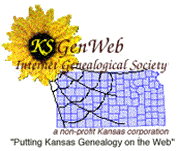 |
Ghost Towns |
 |
 |
Ghost Towns |
 |
|
Trego County, which is located in Western Kansas, is an average sized
county, and measures thirty miles in width and thirty miles in length.
It is believed that the first white man to visit Trego County was J. C.
Fremont, nearly 120 years ago. In 1865, relay stations on the Denver
Trail were established in Trego County. In 1867, these same stations
were burned by the Indians. The legislature of 1868 described the
boundaries of Trego County and named it in honor of Edgar Poe Trego, a
native of Pennsylvania and Captain of Company H., which was attached to
the 8th Kansas Volunteer Infantry. Trego County is bordered by Graham
County on the north, Ness County on the south, Ellis County on the east,
and Gove County on the west.
The following is information about different communities or towns in Trego County that at one time had Post Offices. Out of the twenty listed, only three still have post offices, three still have community gatherings, and the other fourteen are ghost towns, some of which haven't been heard of before. Banner: Banner is located on Section 34, Township 13, Range 25. The community was settled in the late 1870 by farmers, many of them old soldiers who homesteaded the land. On December 8, 1879, A United Slates Post Office was established on land owned by L. W. Purinton. The name "Banner" was suggested by J. C. Brown. E. L. Drake became the first postmaster. The mail was delivered twice a week by horseback. On September- 30, 1918, the post office was discontinued and Rural Route 2 was established. Banner used to have a church, school, post office, store, blacksmith shop, and a creamery. Today, all that is left is the store, which is no longer open, and a church. Bosna: Bosna is located on Section 34, Township 13, and Range 24. A post office was established at Bosna on May 24, 1880, and Frank W. Zeman was the first postmaster. The post office was located in, a small house near the Bosna school house. Bosna was just a district, and, the central meeting place was at the Bosna schoolhouse. When there were quite a few people living in the area, "box suppers" were held, which was one of the few social activities of the community. The Bosna post office closed on August 15, 1921. Today nothing remains of Bosna, but the prairie and a few scattered farm homes. Buckeye: I could not find anything about Buckeye, except that people recalled the name, and they thought it was a community instead of a town. It is believed to be south of the Smoky Hill River. The post office opened in Buckeye on February 23, 1886, and Thomas, W. Miller was the first postmaster. The post office was closed in the same year, April 23, 1886. Collyer: The town of Collyer is located in Section 5, Township 12, Range 25, and is on the main line of the Union Pacific Railroad. It was established in 1879 as a soldier and sailor colony with most of the settlers from Chicago. The town was named after Rev. Doctor Collyer, who was in charge of the soldier's camp. Most of the settlers were members of the Catholic religion., and as a result, today Collyer is almost entirely a Catholic community. The post office was established on May 3, 1878, and Rufus G. Kessler was the postmaster. It used to be a thriving town, with a blacksmith shop, two general stores, a dance hall, and a creamery. Today, the post office is still present, but only the dance hall, one grocery store, and a gas station are left, of the many businesses originally in Collyer. Cyrus: Cyrus established a post office on May 9, 1880 and it closed on March 10, 1889. The first postmaster was James Rogers. This city was moved from Trego County to Ness County, so there is no available information. Gibson: Gibson is another ghost town that I can't find much information about. The post office was established on Dec- ember 30, 1880 and was closed on August 15, 1893. Timothy Arm- strong was the first postmaster. The only scrap of information I could find was that it is believed that Gibson was located in the Southwest corner of Trego County, close to a school called Gibson. Kristof: The Kristof Post Office, which was established on January 22, 1904, was called the Kristof Post Office because it was located in George and Anna Kristof's (my great grandparents) home. The Kristof's, lived in Voda, which was then called Colona, and when a better site was found for the post office, the post office changed locations. So on March 9, 1904, was moved and became known as the Voda Post Office. Frank Bordowsky was the first postmaster, and remained so until he moved to Czechoslovakia. Mendota: Mendota established a post office on February 6, 1882 and closed on November 30, 1909. Harvey M. Hallock was the first postmaster. -shortly after the post office was established, it became part of Ellis County, and there is no available information- . Ogallah: There is much controversy how Ogallah got it's name. Some say it got it from Fort Ogallah, which was located a few miles away, while some claim it was named for the tribe of Indians,-Ogalala (the principal division of the Teton Sioux), while still others say it was named when a woman who thought she had reached her destination, climbed off the train and ex- claimed, '10, golly, how far I can see." According to the last legend, the officials softened and called it Ogallah." Ogallah is located on the south half of Section 23, Township 12, Range 22, in Trego County. The earliest building to be built was the post office. It was built in 1878 and is still standing today. The post office opened on January 27, 1879, with William D. Kelly the postmaster. Ogallah used to have many businesses, but today only the post office, elevator and service station are left. In 195.1, oil was discovered around Ogallah, and many of the people make their living from oil. Probably the most unusual fact about Ogallah was its Forestry Station, established in 1887. Young trees and seeds were planted. These were to be distributed to settlers for making timber claims. One hundred and sixty acres of land was given to a settler, if he would plant and care for ten acres |
|
Article by Mrs. Anna Whisler Written by Ruth Shearer (Articles Taken From) "Local History" As Presented To The Trego County Historical Society (Second Edition - Spring 1974) second printing |
|
|

 |
 |